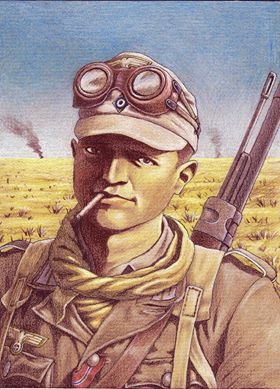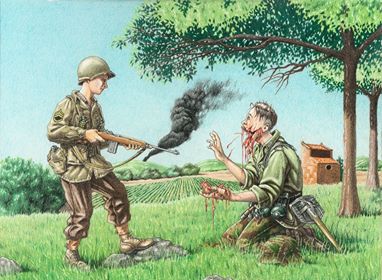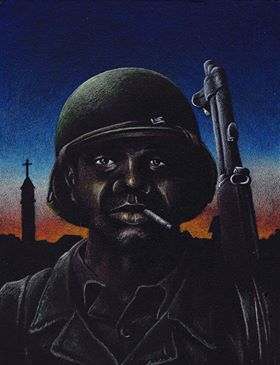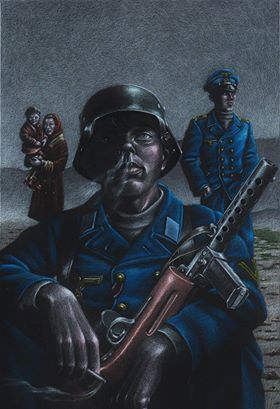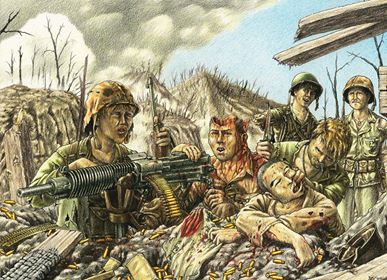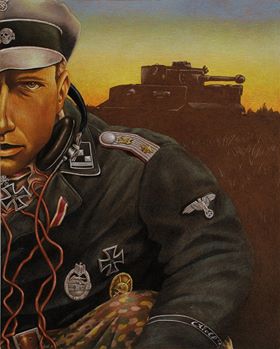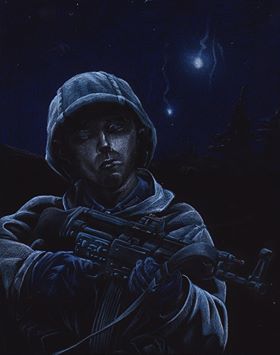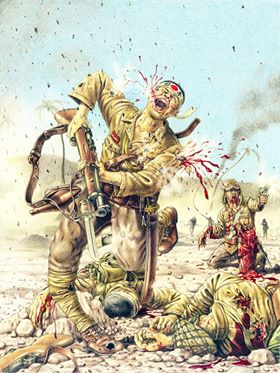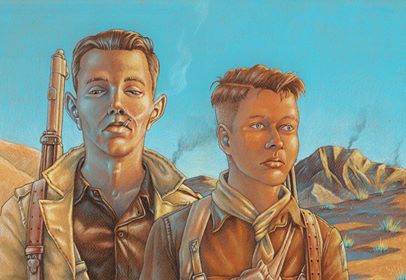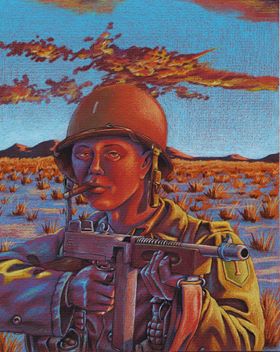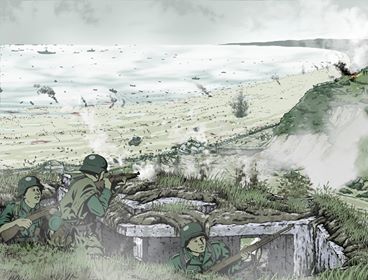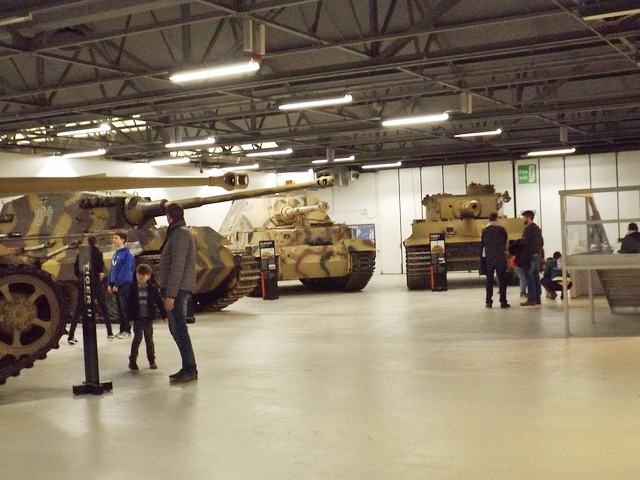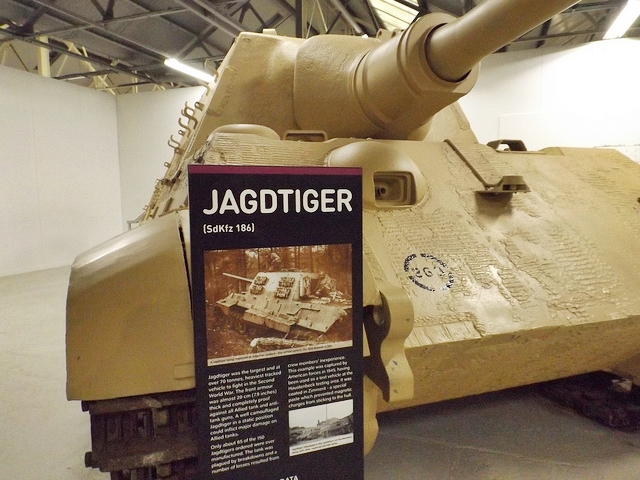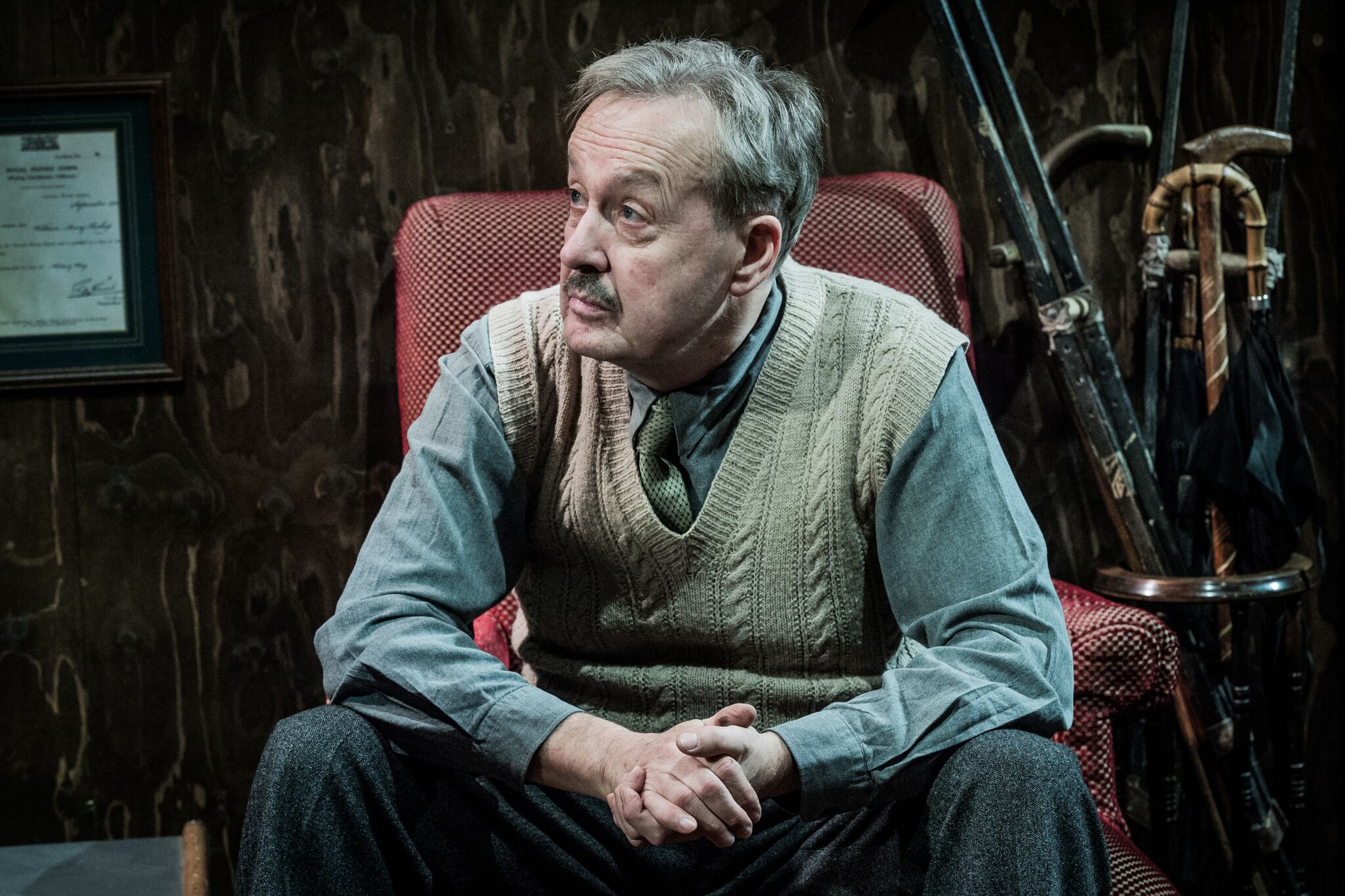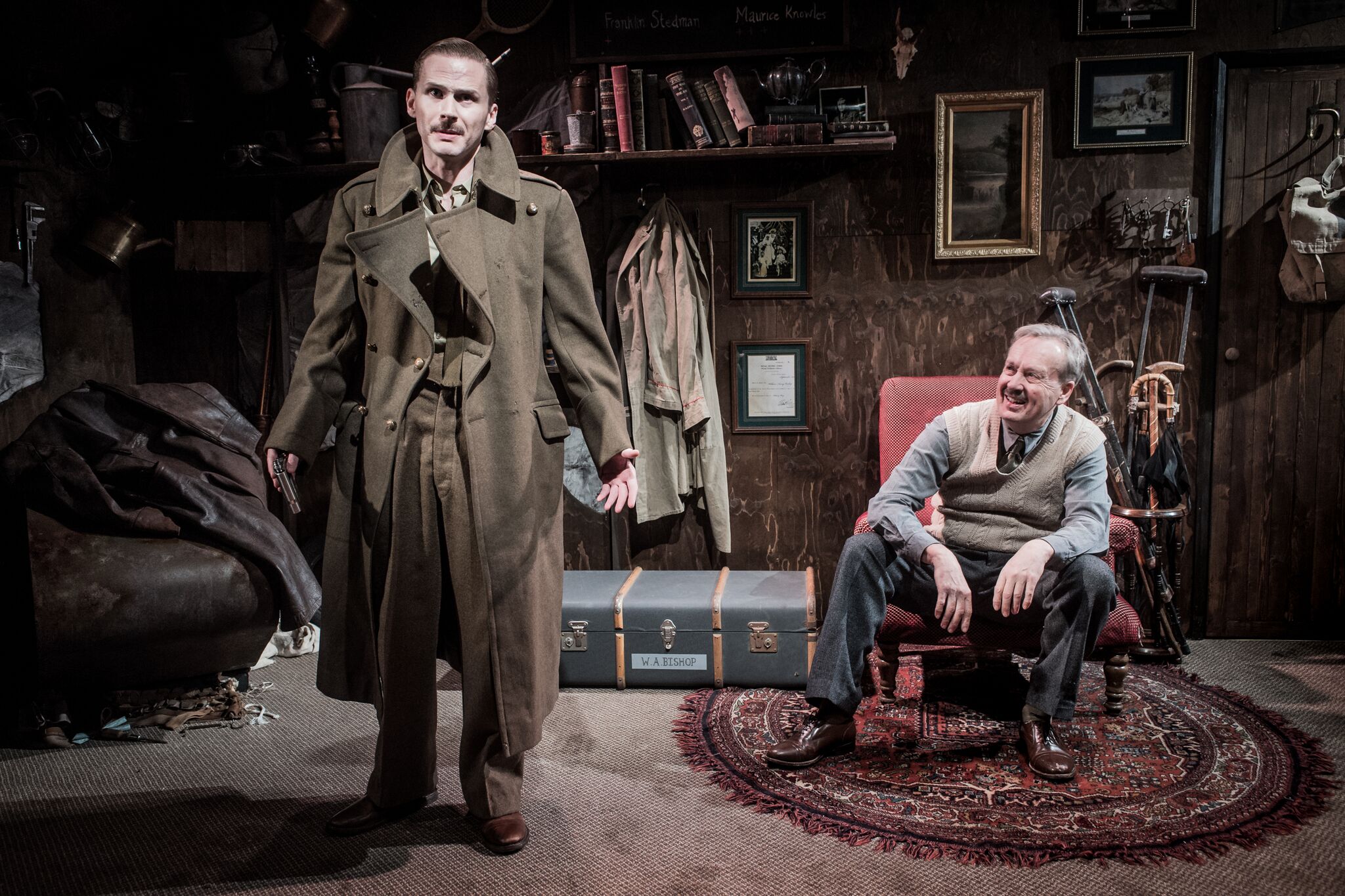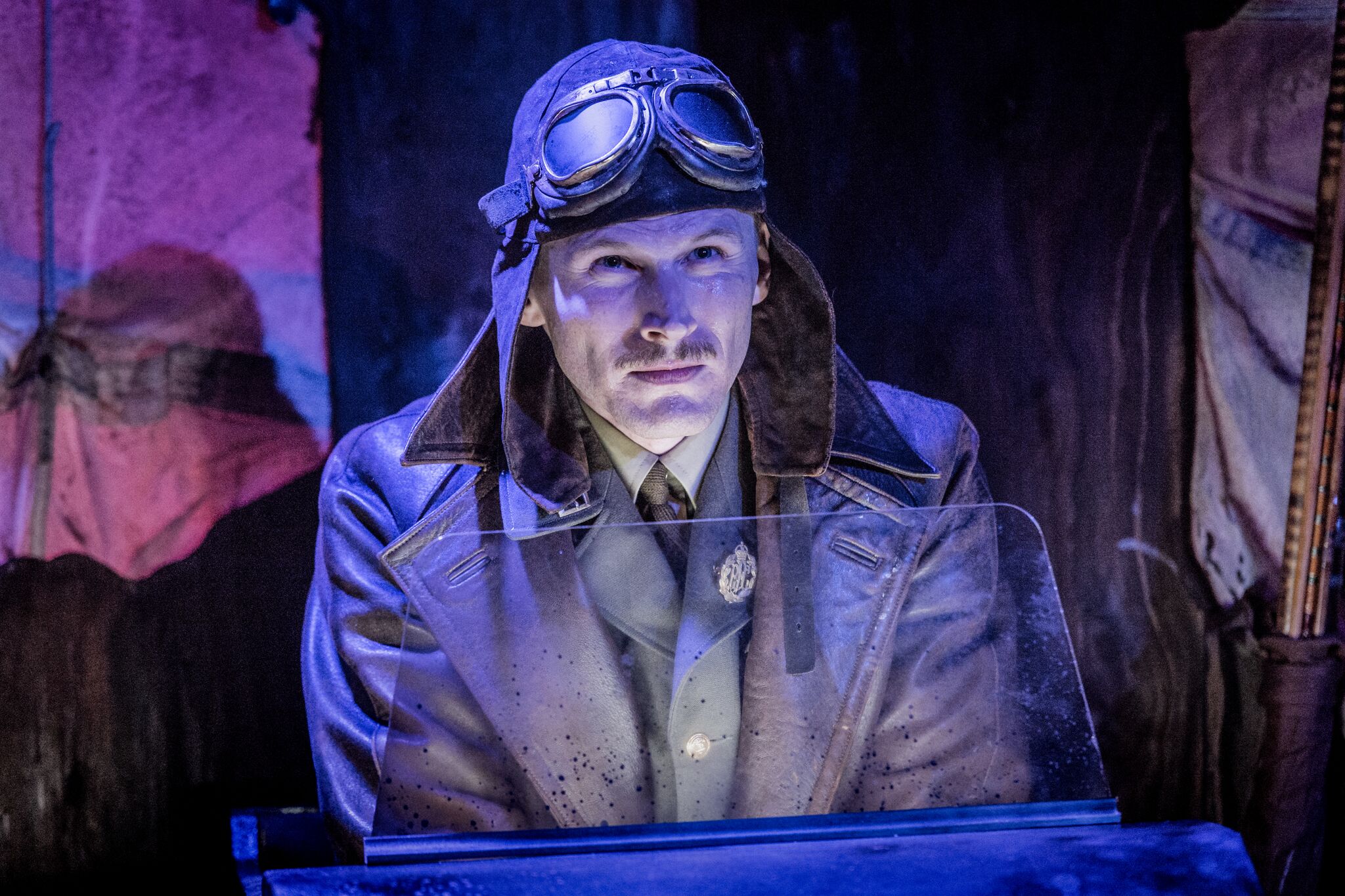
The Second World War resulted in the deaths of around 85 million people. Additionally, tens of millions more people were displaced. However, amid all the carnage people demonstrated remarkable courage, fortitude, compassion, mercy and sacrifice. We would like to honour and celebrate all of those people. In the War Years Blog, we examine the extraordinary experiences of individual service personnel. We also review military history books, events, and museums. And we look at the history of unique World War Two artefacts, medals, and anything else of interest.
D-Day 75th Anniversary Commemoration
As part of the D-Day 75th-anniversary commemorations, The War Years will be adding a range of content over the coming week.
As part of the D-Day 75th-anniversary commemorations, The War Years will be adding a range of content over the coming week.
The Story of D-Day, Part One
The Plan
The largest amphibious operation in military history, code-named Overlord, D-Day started in the early hours of 6 June 1944. The objective was an 80 km stretch of the Normandy coastline. An armada of 7000 ships planned to land 175,000 men, 50,000 vehicles and all their equipment by day’s end. 11,000 aircraft, oil pipelines under the English Channel and even giant Mulberry Harbours would be towed across the sea.
Neptune
Operation Neptune was the naval element of the Overlord plan. 7,000 vessels from battleships to landing craft, Neptune was truly an allied effort. British, American, Canadian, French, Norwegian, Dutch, Polish and Greek vessels all played a part in enabling the landing’s success.
The Landings
The Allies planned to land on 5 beaches code-named Utah, Omaha, Gold, Juno and Sword. The flanks or sides of the planned beachhead would be secured by airborne forces dropped during the night and early morning on 5/6 June.
Pegasus Bridge
Strategically important, the bridges over the Caen Canal and Orne River had to be captured to enable Allied tanks to operate east of the river, and prevent German counter-attacks against the landings.
Seized by a daring glider assault the bridges were successfully captured by Major John Howard’s D Company, 2nd Battalion, Ox and Bucks Light Infantry at just after midnight, 6 June 1944. Once captured it was vital Major Howard’s men held the bridges against counter-attacks until relieved by Lord Lovat’s 1st Special Service Brigade at 1 pm.
Merville
In the area immediately east of Sword Beach, some 4,800 elite airborne troops landed by parachute and glider. Men of the 9th Parachute Battalion took the German coastal battery at Merville that threatened the British landing beaches.
US Paratroops
The American 82nd and 101st Airborne Divisions secured the flanks of the US beaches. However, the 6,600 men dropped were badly scattered that reducing their initial effectiveness, although this did confuse the German defenders. The paratroopers successfully secured the exits from Utah Beach and captured bridges en route to Carentan.
The Story of D-Day, part Two
The American Beaches
Utah Beach
The D-Day landings started at the low water mark on a rising tide at 06.30hrs in the US sector and 07.30hrs for the British.
Strong coastal currents and obscuration of landmarks due to smoke from naval bombardment meant American invasion forces landed 2,000 yards south of their planned objective on Utah Beach. Luckily the area where troops from the 4th Infantry Division actually landed was less heavily defended, and casualties were mercifully light.
Pointe du Hoc
Just as Pegasus Bridge was vital to the success of the British landings so Pointe du Hoc was important to the Americans. Intelligence reports prior to the landings indicated that six 155mm guns in concrete emplacements sat atop a 177ft cliff. The guns threatened the landings on Utah and Omaha Beaches and had to be destroyed.
The elite 2nd Ranger Battalion was tasked with destroying the guns at Pointe du Hoc by direct assault from the sea, which meant scaling the cliffs while under fire. However, when the Rangers fought their way up to the gun emplacements they found them empty. The guns had been moved inland. Later, the guns were found and destroyed.
Omaha Beach
The most difficult terrain and heavily defended sector, Omaha Beach was the objective of the US 1st and 29th Infantry Divisions. At 5.40 am amphibious DD tanks launched 6,000 yards offshore, nearly all sinking in the heavy seas.
Only 5 tanks made it ashore to support the infantry landings. All but one of the 105mm field artillery guns also vital to the landings were lost. To make matters even worse, the naval and air bombardment had done little to reduce the German defensive positions commanding the exposed beach.
Seasick, heavily laden, troops of the nine companies in the first assault wave were decimated by German machine-gun, mortar and artillery fire. Those troops lucky enough to make it across the open beach took cover behind the sea wall.
The assault on Omaha initially stalled. However, gradually men formed small groups and started fighting their way up the bluffs that overlooked the beach. Later, navy destroyers came dangerously close to shore to give much-needed fire support. By day’s end, Omaha Beach was in American hands.
Brigadier General Norman “Dutch” Cota, several NCOs and Privates received decorations for gallantry during the action at "Bloody Omaha".
Today, 3 June 2019, we post a short video taken back in June 2010 on a visit to Omaha Beach and the American Cemetery and Memorial.
The Story of D-Day, part Three
The British, French and Canadian Beaches
Gold Beach
Westernmost of the British/Canadian beaches, code-named Gold, were assaulted by the 50th Division of the British XXX Corps. Specially developed armoured vehicles were landed ahead of the infantry to deal with beach obstacles, mines and the sea wall. Some 2,500 obstacles and mines needed to be cleared from Gold Beach alone. Allied forces quickly overcame German defences and moved inland.
During the advance of the 69th Brigade, Company Sergeant Major, Stan Hollis of the Green Howards won the Victoria Cross, for repeated acts of valour, Britain’s highest military honour. This was the only VC won on D-Day.
Juno Beach
Canada made a terrific contribution to the Allied war effort. Juno Beach was assigned to the Canadian 3rd Division. Like the British, the Canadians used special armoured vehicles to help overcome beach obstacles, mines and strong points. These vehicles were nick-named Hobart’s “funnies” after their creator Major General Sir Percy Hobart.
The town of Courseulles was strongly defended by the Germans but duly taken. The Queens Own Rifles suffered severe casualties crossing the beach at Bernieres. The Canadians made contact with 50th Division on their right by day’s end.
Sword Beach
The easternmost landing zone, Sword Beach, was assaulted by the British 3rd Division. The 3rd Division’s objectives were perhaps the most ambitious of the D-Day operation: capture or mask the Norman city of Caen by nightfall. The 3rd Division also knew it was likely to be counter-attacked by tanks of the German 21st Panzer (Armour) Division.
British intentions to quickly move off Sword Beach and drive inland were held up by resistance from German strong points. British troops reached Lebisey Wood, just three miles short of Caen, but could advance no further.
Special Forces - The Commandos
French Commandos led by Philippe Kieffer took Ouistreham casino and secured the canal gateway. However, the French suffered heavy casualties and Kieffer was wounded twice during the fighting.
Commandos of the 1st Special Service Brigade landed on the 'Queen Red' sector of Sword Beach at approximately 8.40 am, 6 June 1944. Commanded by Brigadier Simon Fraser, Lord Lovat, the 1st Special Service Brigade’s mission was to push inland and link up with the lightly armed British 6th Airborne Division holding Pegasus Bridge and bridge over the Orne River.
Today, we have added 241 photos to our Flickr site taken during visits to the D-Day beaches, Pegasus Bridge Memorial and Museum, Normandy American Cemetery and Memorial, Omaha Beach Memorial Museum, Airborne Museum, Sainte-Marie-du-Mont and Sainte-Mère-Église in 2010 and 2014.
WW2 Artwork of Michael Akkerman
In this blog post, we showcase the emotive, World War Two-inspired artwork of Michael Akkerman from the famous faces of Audie Murphy and Eugene Sledge to the bloody realities of the battlefield.
Michael Akkerman is an American artist whose work is heavily influenced by World War Two (WW2) military history. Michael has kindly allowed The War Years to show some of his work here. Probably the most recognised subject of Michael’s work is Hollywood legend, Audie Murphy. He was one of the most decorated American soldiers of WW2, winning the Medal of Honor aged 19. After the war, Murphy had a successful acting career, as a songwriter and horse breeder. Sadly, he was killed in a plane crash in 1971. He was only 45 years old. One of Michael’s pictures is inspired by an episode taken from Murphy’s wartime autobiography, where he felt compelled to shoot a badly wounded young German soldier as an act of mercy.
Eugene Sledge is another name that will be familiar to many people with a passing interest in the Second World War. He served in the US 5th Marines, 1st Marine Division fighting in the Pacific. His book, ‘With the Old Breed: At Peleliu and Okinawa’ became a bestseller when published in the 1980s. His book and Robert Leckie’s ‘Helmet for My Pillow’, also served as inspiration for the HBO miniseries The Pacific. The savage, relentless fighting of the Pacific campaign had a dehumanising effect on many of the combatants. However, somehow, Eugene Sledge was able to hold onto his humanity amidst the horror, which is vividly illustrated in Michael Akkerman’s artwork.
Made famous by Nazi propaganda and a legend by the battle of Villers-Bocage, Michael Wittmann was a German tank ace with an impressive tally of 138 kills, mainly achieved on the Russian Front. He is also the subject of one of Michael Akkerman’s paintings. A week after the D-Day landings, SS-Hauptsturmführer Wittmann and his Tiger tank bumped into the forward elements of the British 7th Armoured Division. Wittmann attacked the British column and destroyed 14 tanks, 15 personnel carriers and two anti-tank guns in an engagement that lasted about 15 minutes. Wittmann was awarded the Knight's Cross with Oak Leaves and Swords and became a propaganda star. However, he would be killed just two months later. His remains would not be found and positively identified until 1983.
As well as the famous and infamous, Michael Akkerman’s paintings capture some of the more mundane and human elements of the Second World War, from the black ‘Buffalo Soldiers’ of the US Army to the hardships of the North Africa campaign. He also depicts the bloody realities of the Japanese Banzai charge and the lethal efficiency of the German MG-42 machine guns used to defend Omaha Beach on D-Day. To learn more about Michael’s artwork or to get a quote for a commission, you can find him on Facebook.
Book Review: Courage After The Battle by Peter Jackson-Lee
Courage After The Battle written by ex-Royal Marine and Falklands veteran Peter Jackson-Lee is a book that takes the reader on a journey that most people will never experience. The book is a travelogue that explains how service men and women navigate their way from battlefield injury back to civilian life. Read the full book review now
Courage After The Battle written by ex-Royal Marine and Falklands veteran Peter Jackson-Lee is a book that takes the reader on a journey that most people will never experience. The book is a travelogue that explains how service men and women navigate their way from battlefield injury back to civilian life. The book also examines the history of battlefield medicine, mental healthcare, prosthetics, reconstructive surgery, politics and changes in social welfare. At turns, the book is inspiring, fascinating and deeply troubling.
The book takes a systematic look at what happens to service personnel from the moment they suffer a life-changing wound on the battlefield. It explains the process of evacuation, emergency trauma care and transition to the hospital. Next, the book explains the many different types of battlefield trauma: loss of limbs, facial disfigurement, deafness and blindness. The book also looks at various treatments available such as prosthetics and plastic surgery. However, it is the long shadow cast by mental health and social care issues such as post-traumatic stress disorder (PTSD), depression, drug addiction, alcohol abuse and homelessness that I found the most disturbing. The destructiveness of these hidden wounds, if not treated quickly, spreads out like a pressure wave damaging family, friends and wider society.
The final third of Peter Jackson-Lee’s book explains the covenant between the Armed Services, the Nation and UK Government. The book also lists around 150 national charities and other organisations that provide help and support to current service personnel, veterans and their families. The fact that over 70 pages of the book simply list charitable organisations that offer support is alarming. It demonstrates the betrayal of the Armed Forces Covenant, and the abject failure of government policies stretching back decades. In many ways, this book is the story of a shocking, perennial national disgrace.
The book is written in a balanced, no-nonsense, straightforward style and tone. Peter Jackson-Lee lets the veterans, families, healthcare professionals, charity workers and facts speak for themselves. He explains the history of every technical, medical and procedural advance that makes suffering a battlefield injury move survivable. However, while the overall survivability of battlefield injuries has steadily increased, the opposite is true of long-term care. Consecutive governments have overseen punitive cuts in the provision of everything from mental healthcare to housing, and much more besides.
From Trafalgar, Waterloo and the Battle of Britain to the Falklands, Iraq and Afghanistan, the Armed Services have always been there to protect this country’s national interests with their lives. Nevertheless, the compact between the State and its servicemen and women has always been an unequal one. Service personnel are expected to make the ultimate sacrifice without complaint when called upon to do so. In contrast, our politicians, the Ministry of Defence (MOD) and civil servants can renege on every promise and betray every commitment. While our service men and women are driven by loyalty, courage and comradeship, the politicians and bureaucrats are driven by arrogance, ignorance and greed.
Reading Courage After The Battle makes you ask the question, why would anyone join the Armed Services? In 2018, a National Audit Office (NAO) report found the Armed Services had a shortfall of 8,200 regulars (full-time service personnel). In December 2018, it was widely reported that a £495m contract with the outsourcing giant Capita had clearly failed to achieve the Army’s recruitment targets. What’s more, half of the Army’s applicants subsequently dropped out of the process. Another monumental waste of public money that could have been better spent elsewhere.
Interestingly, a Harvard Institute of Politics (IOP) survey found that while many millennials (18 to 29 years old) generally supported the US military’s war against Islamic State (ISIS), they themselves did not want to take part. One reason many millennials gave for not wanting to join the US military was a “deep distrust about all things relating to the government.” Clearly, books like Courage After The Battle can help today’s young people make better-informed decisions about joining the military, and the potential long-term consequences of doing so. The book also shines a light on the many shameful actions perpetrated by British politicians, civil servants and bureaucrats against our veterans and their families. Something to think about the next time you go to the polls.
Courage After The Battle is published by Brown Dog Books.
Face to Face with the German Tiger tank
In this article, we look at the merits and deficiencies of the German Tiger tank during World War Two, and the muddled strategic thinking that drove the project forward.
The Tiger tank (Panzerkampfwagen VI Tiger Ausf. E) entered service at the end of 1942. It was not a great start. The tank was deployed over unsuitable terrain, limiting its effectiveness. The early production Tigers were plagued with technical problems including dangerous engine fires. Many of these early teething problems were symptoms of the tank being rushed into service without adequate development and testing. However, the Tiger was also over-engineered. The result was a highly complex, often temperamental weapons system that required extensive preventative maintenance and careful handling.
Fighting the Wrong War
Manufactured by Henschel, the Tiger I Ausf. E was the product of creaky strategic thinking. The Tiger was not built in response to Soviet tanks like the T-34 and KV-1. Instead, the Tiger was designed as a “sledgehammer” to smash holes in the enemy’s lines, which support units could then exploit. However, the Germans were already fighting a largely defensive war by late 1942. The days of the blitzkrieg were over. A far better solution would have been to concentrate all manufacturing resources on producing the reliable, very effective Panzer IV main battle tank (MBT).
60 Tonne Sledgehammer
Although the Tiger had many deficiencies, it was not without merit. In the hands of a well-trained and experienced crew who understood the Tiger’s advantages, the tank could prove a formidable opponent. Tank design is about achieving the right balance of mobility, armour and firepower so the vehicle can perform its primary task. Clearly, the Tiger was designed as a sledgehammer, and that’s what the panzer forces got. The Tiger weighed in at just under 60 tonnes, with 100mm frontal armour, 80mm side and rear armour, two MG-34 machine guns, and a high velocity, flat trajectory 88mm main gun.
40 Percent Reliable
The Tiger’s 88mm main gun fired both armour piercing (AP) and high explosive (HE) shells. Officially, the tank could store 92 rounds. However, crews typically packed as many additional shells into every available space as possible. Although the tank was underpowered by the Maybach HL230 700-horsepower petrol engine, it was surprisingly quick and agile on good ground. A semi-automatic gearbox and steering wheel also made the tank easy to drive. Nevertheless, even when the tank was well maintained and supported by a good workshop company, the Tiger’s overall reliability was abysmal. Most Tiger Is were only operational 40 per cent of the time. The reliability of other Tiger variants such as Tiger II Ausf. B, Panzerjager and Jagdtiger were even worse.
Recovery No Easy Task
Naturally, broken down and battle-damaged tanks need to be recovered, whenever possible. Unfortunately, the Tiger’s size and weight often worked against easy recovery. Typically, it took two or three prime movers (tractors) to tow a Tiger to safety. Panzer units were under strict orders not to use one Tiger to tow another, as this could result in damaging the second tank. However, necessity often trumped orders and Tigers frequently towed one another. Later, specialist recovery tanks were introduced, such as the Bergepanther, but these vehicles were always in short supply.
The Importance of Training
How well or poorly an individual tank performs is mainly reliant on the quality and training of the crew. As the war progressed and losses mounted, the German army struggled to provide adequate manpower or training to its panzer forces. Subsequently, overall performance suffered. However, the Germans valued the lives of their panzer crews, and the Tiger provided a separate escape hatch for each man. Many Allied tanks were not designed as well, resulting in men being trapped inside burning vehicles after they had been hit. When it came to training Tiger crews, the official manual was surprisingly innovative. The Tigerfibel aimed to convey complex battlefield instructions in a simple and memorable manner to young recruits using cartoons, jokes and risqué pictures of women. Even today, you can buy a copy in English translation on Amazon.
The Unsinkable Tiger
Thanks to a combination of thick, seemingly impervious frontal armour, the legendary 88mm gun and copious amounts of Nazi propaganda, the Tiger quickly gained a reputation for impregnability. Of course, the Tiger was as impregnable as the Titanic was unsinkable. In reality, the Tiger’s main value came from its ability to stand off and deal with its opponents at a distance. However, even with mid and late-production improvements, by 1944 the Tiger was fighting a losing battle.
The Victory of Mass Production
The Germans went for quality over quantity in tank production, but a lack of time and resources meant they never really delivered on quality. They also chose to pursue an obsolete military strategy at odds with the realities of their situation. In contrast, the Allies went for simple, reliable vehicles they could mass-produce in vast quantities. Over 110,000 Soviet T-34 and American M4 Sherman medium tanks were manufactured compared with just over 1,300 Tiger I Ausf. E. That’s 85 to one, and only half the Tigers would be fit for service at any time. What’s more, the Allies didn’t stand still. They improved their existing tank forces and introduced new, heavier tanks. The British Comet, for example, entered service in December 1944. Ultimately, the Tiger only ever won the propaganda war. In all other respects, the Tiger was a costly, unreliable failure.
Review: Billy Bishop Goes to War at the Jermyn Street Theatre
In this blog post, we review the latest production of the musical drama Billy Bishop Goes to War at the Jermyn Street Theatre. The production recounts the extraordinary life and career of Canadian WW1 flying ace Billy Bishop. The play is running Wed, 31st October - Sat, 24th November 2018.
Usually, just two words would deter me from buying tickets to a show: musical theatre. So, it was with some trepidation that I accepted an invitation to watch the latest production of Billy Bishop Goes to War at the Jermyn Street Theatre, London. However, the moment actor Oliver Beamish began playing the piano and started to sing, I immediately knew I could strap myself in, sit back and enjoy the ride. In that tiny theatre, as intimate as any cockpit, with consummate professionals at the controls, we would navigate the career of WW1 Canadian flying ace Billy Bishop.
Written by John Gray with Eric Peterson, Bill Bishop Goes to War tells the wartime story of William (Billy) Avery Bishop during the period 1914 to 1917. The play also touches briefly on Billy’s military contribution during the Second World War. Billy made for an unlikely hero. He showed no promise as a young cadet at the Royal Military College of Canada (RMC), where he failed his first year and was caught cheating. He was somewhat accident-prone, and suffered bouts of stress-related illness. Nevertheless, he found himself commissioned as a cavalry officer and shipped across the North Atlantic to England in 1915. Two ships in his convoy were torpedoed by German U-boats with the loss of over 200 men.
While stationed in France during the summer of 1915, Billy transferred to the Royal Flying Corps (RFC) as an observer. In March 1917, he became a pilot joining the 60 Squadron at Filescamp Farm near Arras. At that time, the average life expectancy of a new pilot was just 11 days. Once again, Billy’s career as a pilot got off to a shaky start. He crash-landed his aircraft during a practice flight in front of General John Higgins. However, within a few short months, Billy was awarded the Victoria Cross for a solo attack against a German aerodrome. By August 1917, he had surpassed the late Albert Ball’s tally of “kills”. Billy was on his way to becoming one of the conflict’s greatest fighter aces. After a brief period of leave in Canada, where he got married, Billy returned to the fray. Eventually, he was promoted out of harm’s way as Officer Commanding-designate of the Canadian Air Force Section of the General Staff, Headquarters Overseas Military Forces of Canada. By the war’s end, he had claimed 72 aerial victories, including two balloons.
During World War Two, Billy Bishop was appointed Director of the Royal Canadian Air Force and placed in charge of recruitment. In 1942, he appeared as himself in the Hollywood movie Captains of the Clouds. In 1944, Billy’s old foe stress-related illness forced him to resign. He died in his sleep on 11 September 1956, aged 62.
The Jermyn Street Theatre is a small, subterranean gem. The intimacy of the space and excellent set design by Daisy Blower created the feeling of being in a First World War dugout. Packed with the memorabilia of the older Billy’s extraordinary life, even the most mundane items such as a suitcase and an old red armchair were transformed into meaningful props. In a time when audiences can be blasé about multi-million dollar movie special effects, it was wonderful to see a swinging lamplight create the illusion of movement as Billy crossed the ocean aboard the ship Caledonia. A vessel designed to ship cattle, not men.
First staged in 1978, this revival of Billy Bishop Goes to War has more than a touch of the BBC sitcom Blackadder Goes Forth. Directed by Jimmy Walters, this musical drama moved seamlessly between comedy and tragedy. Actors Charles Aitken and Oliver Beamish did a brilliant job of portraying Billy in his youth and later life. They immediately established a wonderful rapport with the audience. Oliver Beamish provided the piano and musical accompaniment while Charles Aitken brought amazing physical energy to the performance. The two actors played an additional 17 characters. I particularly liked Charles Aitken’s Lady St. Helier, Billy’s patron in London society. He seemed to be channelling actress Frances de la Tour.
As the Jermyn Street Theatre is a registered charity, I was a little disappointed that the small auditorium was not sold out, and about a third of the seats were empty. I was also surprised the production is only running until 24 November 2018. Just days before the centenary of the end of the First World War, Billy Bishop Goes to War reminds us of the immense courage, perseverance and sacrifice of ordinary men who served in the “Great War”. The drama also examines the tensions between the British establishment and its “colonial” cousins, who were good enough to fight and die for the empire while being widely regarded as second-class citizens. Overall, the show is a wonderful, poignant piece of musical theatre that teaches us ordinary people can do the most extraordinary things.
Production photography courtesy of Robert Workman
World War One Missing Manuscript Returns Home
In this book review we take a look at a lost manuscript of the Great War finally published. Field Dressing by Stretcher Bearer, France 1916 – 1919, is a slim volume of World War One poems by Alick Lewis Ellis. He served as a stretcher bearer with the 2/3rd London Field Ambulance, 54th Division, London Regiment, and took part in the Battle of the Somme, Arras, Ypres and Cambrai.
Field Dressing by Stretcher Bearer, France 1916 – 1919, is a slim volume of World War One poems by Alick Lewis Ellis. He served as a stretcher bearer with the 2/3rd London Field Ambulance, 54th Division, London Regiment, and took part in the Battle of the Somme, Arras, Ypres and Cambrai. During his time on the Western Front, Alick took to writing poetry to capture and make sense of his experiences. His notebook of poems was lost for nearly a hundred years until someone anonymously handed it to Dan Hill at the Herts at War Society in 2017. Dan Hill subsequently tracked down Alick’s remaining family, and together they worked to publish Field Dressing by Stretcher Bearer. To recognise the essential role played by the Royal Army Medical Corps (RAMC) and military mental health charities, a proportion of the book’s profits will go to Combat Stress and Veterans With Dogs.
Alick Lewis Ellis appears to have led an unremarkable life. He had a basic education and looked forward to a career as a grocer if the war had not intervened. His war poems might not have the literary complexity and construction of Wilfred Owen, Robert Graves and Siegfried Sassoon. Nevertheless, they have merit and share many common themes with the famous war poets of his generation. His poems reflect the direct experiences of war. They celebrate their comrades, condemn the war leaders, scorn the indifference of many civilians, and express a longing for home. Unfortunately, we know nothing of Alick’s creative influences or inspirations. The documentary of his life is reduced to a few faded photos, sketchy family memories and military service records.
Regardless of the many horrors and privations of the Western Front, Alick seems to have maintained his sense of humour. In poems like Revenge, he jokes about the quality of Army food, especially the rock-hard biscuits issued to the troops. In Training and Reality, he uses humour to illustrate just how poorly depot life and parade ground drill prepared soldiers for combat. After the war, Alick returned to working in retail, but little else about his life is known. Sadly, he passed away in November 1953. Alick’s poems might not be the greatest literary works, but they are honest, funny and poignant. Regrettably, they tell us familiar stories as old as war itself.




